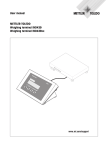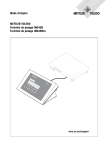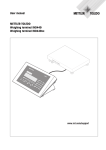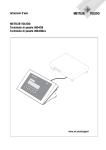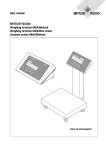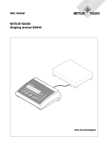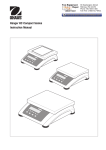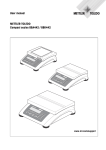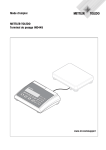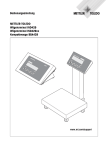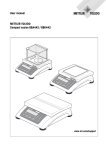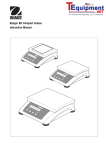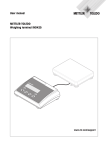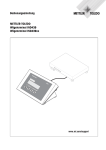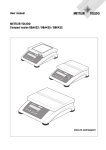Download User manual METTLER TOLEDO Weighing terminal IND439
Transcript
User manual METTLER TOLEDO Weighing terminal IND439 Weighing terminal IND439xx IND 439 www.mt.com/support @@@@@ Congratulations on choosing the quality and precision of METTLER TOLEDO. Proper use according to this Operating Manual and regular calibration and maintenance by our factory-trained service team ensures dependable and accurate operation, protecting your investment. Contact us about a ServiceXXL agreement tailored to your needs and budget. We invite you to register your product at www.mt.com/productregistration so we can contact you about enhancements, updates and important notifications concerning your product. IND439 / IND439xx Table of contents Table of contents Page 1 1.1 1.2 1.3 1.4 1.5 1.6 User manual 22013806B 05/08 Introduction .....................................................................................5 Safety instructions for the explosion protected weighing terminal IND439xx ........................................................................................5 Safety instructions for non-explosion-protected devices .........................6 Disposal ..........................................................................................7 Use in hygienically sensitive areas .....................................................7 Description ......................................................................................8 Commissioning ..............................................................................12 2 2.1 2.2 2.3 2.4 2.5 2.6 2.7 2.8 2.9 2.10 2.11 2.12 Operation ......................................................................................15 Switching on and off .......................................................................15 Zeroing / Zero point correction ..........................................................15 Simple weighing .............................................................................15 Weighing with tare ..........................................................................16 Calling up the gross weight and tare value .........................................17 Displaying weight values with a higher resolution ...............................17 Displaying the capacity available ......................................................17 Dynamic weighing ..........................................................................17 Printing results ...............................................................................18 Switching scales .............................................................................18 Cleaning ........................................................................................19 Testing of weighing terminal and scale/display of the ID code (only for weighing terminals with IDNet interface) ...............................20 3 3.1 3.2 3.3 3.4 3.5 3.6 3.7 Counting .......................................................................................21 Counting parts into a container .........................................................21 Counting parts out of a container ......................................................21 Counting with variable reference quantity ...........................................22 Counting with minimum accuracy ....................................................22 Reference optimization ....................................................................22 Counting with automatic reference determination ................................23 Counting with two scales .................................................................23 4 4.1 4.2 4.3 4.4 4.5 4.6 4.7 4.8 Settings in the menu ......................................................................25 Operating the menu ........................................................................25 Overview .......................................................................................27 Scale settings (SCALE) – analog ......................................................31 Scale settings (SCALE) – IDNet .........................................................33 Application settings (APPLICATION) ..................................................35 Terminal settings (TERMINAL) ..........................................................36 Configuring interfaces (COMMUNICATION) .........................................37 Diagnosis and printing out of the menu settings (DIAGNOS) ................42 3 IND439 / IND439xx Table of contents 4 5 5.1 5.2 5.3 Interface description ......................................................................43 SICS interface commands ................................................................ 43 TOLEDO Continuous mode .............................................................45 MMR interface commands ...............................................................47 6 Event and error messages .............................................................. 50 7 7.1 7.2 Technical data and accessories ......................................................53 Technical data ...............................................................................53 Accessories ...................................................................................56 8 8.1 8.2 8.3 8.4 8.5 Appendix ......................................................................................58 Safety checks .................................................................................58 Tests for utilisation in hygienically sensitive areas ..............................58 Working to GMP (Good Manufacturing Practice) ................................59 Tables of geo values .......................................................................59 FCC ..............................................................................................62 9 Index ............................................................................................63 User manual 22013806B 05/08 IND439 / IND439xx 1 Introduction Introduction 1.1 Safety instructions for the explosion protected weighing terminal IND439xx The device fulfils Device category 3 and is approved for operation in Zone 2 (gases) and Zone 22 (dusts) hazardous areas. There is an increased risk of injury and damage when used in hazardous areas. Special care must be taken when working in such hazardous areas. The code of practice is oriented to the "Safe Distribution" concept drawn up by METTLER TOLEDO. Competence ▲ The device, accompanying weighing platforms and accessories may only be installed, maintained and repaired by authorized METTLER TOLEDO service personnel. ▲ The mains connection may only be connected or disconnected by the owner’s electrician. Ex approval ▲ For the exact specification please refer to the statement of conformity. ▲ No modifications may be made to the terminal and no repair work may be performed on the modules. Any weighing platform or system modules that are used must comply with the specifications contained in the installation instructions. Non-compliant equipment jeopardizes the safety of the system, cancels the Ex approval and renders any warranty or product liability claims null and void. ▲ The cable glands must be tightened so that a strain relief of ≥ 20 N per mm cable diameter is ensured. ▲ When connecting external devices, always observe the maximum permissible connected loads, refer to the installation instructions. It must be ensured that no voltages are fed into the device than it itself provides. The interface parameters have to fulfil the standard. ▲ Peripheral devices without an Ex approval may only be operating in nonhazardous areas. It must be ensured that no voltages are fed into the device than it itself provides. In addition the maximum permissible connected loads have to be observed, refer to the installation instructions. The interface parameters have to fulfil the standard. ▲ The safety of the weighing system is only guaranteed when the weighing system is operated, installed and maintained in accordance with the respective instructions. User manual 22013806B 05/08 5 IND439 / IND439xx Introduction Ex approval ▲ Also comply with the following: – the instructions for the system modules, – the regulations and standards in the respective country, – the statutory requirement for electrical equipment installed in hazardous areas in the respective country, – all instructions related to safety issued by the owner. ▲ Before initial start-up and following service work, check the explosion protected weighing system for the proper condition of all safety-related parts. Operation ▲ Prevent the build-up of static electricity. Therefore: – always wear suitable working clothes when operating or performing service work on the system, – do not rub or wipe off the keyboard surface with a dry cloth or glove. ▲ Do not use protective hoods. ▲ Prevent damage to the weighing terminal. Hairline cracks in the keyboard membrane are also considered damage. ▲ If the weighing terminal, accompanying weighing platforms or accessories are damaged: – Switch off weighing terminal. – Separate the weighing terminal from the mains in accordance with the applicable regulations. – Secure the weighing terminal against accidental start-up. ▲ Always charge the storage batteries in a safe zone. ▲ Ensure that the supply voltage at the installation site amounts to 230 V. 1.2 Safety instructions for non-explosion-protected devices ▲ Do not use the device in an hazardous environment! Special devices are available in our range of products for hazardous environments. ▲ Ensure that the power socket outlet for the device is earthed and easily accessible, so that it can be de-energized rapidly in emergencies. ▲ Ensure that the supply voltage at the installation site lies within in the range of 100 V to 240 V. ▲ The safety of the device cannot be ensured if it is not operated in accordance with these operating instructions. ▲ Only authorized personnel may open the device. ▲ Check the power cable regularly for damage. If it is damaged, disconnect the device immediately from the power supply. ▲ Ensure that there is a space of at least 3 cm at the rear in order to prevent the power cable from being bent too strongly. 6 User manual 22013806B 05/08 IND439 / IND439xx Introduction 1.3 Disposal In conformance with the European Directive 2002/96 EC on Waste Electrical and Electronic Equipment (WEEE) this device may not be disposed of with domestic waste. This also applies to countries outside the EU, per their specific requirements. ➜ Please dispose of this product in accordance with local regulations at the collecting point specified for electrical and electronic equipment. If you have any questions, please contact the responsible authority or the distributor from which you purchased this device. Should this device be passed on to other parties (for private or professional use), the content of this regulation must also be related. Thank you for your contribution to environmental protection. If the device is equipped with a storage battery: The nickel metal hydride (NiMH) storage battery does not contain any heavy metals. However, it may not be disposed of with the normal refuse. ➜ Observe the local regulations on the disposal of materials that are hazardous to the environment. 1.4 Use in hygienically sensitive areas The device is suitable for use in hygienically sensitive areas. It fulfils the following requirements on areas coming into contact with the product (keyboard) and areas not coming into contact with the product (housing, stand): • Suitability of the materials for contact with foodstuffs • Continuous bonding joints that do not act on the material • Smooth, non-porous and flat surfaces that are easy to clean • Continuous welding seams • No sharp corners For further information please refer to Sections 8.2 and 8.3. User manual 22013806B 05/08 7 IND439 / IND439xx Introduction 1.5 1.5.1 Description Weighing terminals IND439 and IND439xx METTLER TOLEDO weighing platforms can be connected without problems to the weighing terminals. The weighing terminals are available in two different basic versions: for connecting analog scales or for digital scales with IDNet interface. Both basic versions are supplied by default with in-built power supply unit and an RS232 interface. IND439xx is approved for use in hazardous areas of the Category 3. 1.5.2 Additional equipment The following alternatives are also possible: • Power supply via in-built storage battery • Version for external power supply 12 – 24 V DC • Power supply via an external storage battery (not for IND439xx) • Second analog scale interface • Second IDNet scale interface • Additional second communication interface One of the following options is available as the second communication interface: • RS232 • RS485/RS422 • Ethernet interface • USB interface • Digital I/O • WLAN 8 User manual 22013806B 05/08 IND439 / IND439xx Introduction 1.5.3 1 Keys 2 Display 3 Measuring data sign Overview 3 2 1 1 Power supply connection 2 Pressure compensation 3 Equipotential bonding terminal, only for IND439xx 4 COM1 interface 5 COM2 interface (optional) 6 Antenna for optional WLAN interface 7 Connection of second scale 8 Connection of first scale 9 Securing plate for the interface connections, only for IND439xx User manual 22013806B 05/08 1 2 3 4 5 6 7 8 9 9 IND439 / IND439xx Introduction 1.5.4 Display 1 2 3 4 5 6 15 14 13 7 8 9 12 11 10 1 7-segment display, 7 digits, with decimal point 2 Notation for weight values with e = 10 d 3 Active interface 4 Symbol for displaying gross and net values 5 Active scale 6 Weighing range display 7 Charge state of the storage battery, only for devices with storage battery 8 Weight units 9 Selected reference number of pieces 10 Symbols for optimizing the average piece weight 11 Symbol for dynamic weighing 12 Graphics display of the weighing range 13 Standstill check (goes out when a stable weight value has been reached) 14 Sign 15 Notation for modified or calculated weight values, e.g. higher resolution, weight below minimum value 10 User manual 22013806B 05/08 IND439 / IND439xx Introduction 1.5.5 Keyboard Main functions Key 0 Function in the operating mode Function in the menu Switch the terminal on/off; cancel To the last menu item –End– Set scale to zero, delete tare Page backwards Long keypress at scales with IDNet interface: Display of the ID code and checking of the calibration Tare scale, delete tare Page forwards Transfer key Activate menu item Long keypress: Call up menu Accept selected setting T Additional functions Key Function Switch over between gross and net weight; display the tare specification Weight display in a higher resolution Switch over scale Switch over between weight value and number of pieces Determine average piece weight from 10 pieces Determine average piece weight from any number of pieces (1 – 199 pieces) User manual 22013806B 05/08 11 IND439 / IND439xx Introduction 1.6 Commissioning The weighing platform connection to the weighing terminals IND439 / IND439xx as well as the commissioning of the interfaces are described in the "IND4x9 / BBA4x9" installation instructions. ➜ Call the METTLER TOLEDO service or carry out commissioning in accordance with the installation instructions. 1.6.1 Limited mobility at explosion protected weighing terminal IND439xx CAUTION! The device may only be operated in Zone 2 and 22 hazardous areas. ▲ Protect data and signal cable extensions against inadvertent disconnection. ▲ Secure the interface connections on the rear using the interface plate. 1.6.2 Labelling for operation in hazardous area The following signs must be mounted on the device, accompanying weighing platforms and accessories so that they are clearly visible: • Model plate and the device’s model data, manufacturer and serial number • Safety instructions • Explosion protection identification • If appropriate, temperature range 1.6.3 Establishing a mains connection at an explosion protected weighing terminal IND439xx CAUTION! The mains connection may only be connected by the owner’s electrician. CAUTION! The device only operates correctly at a supply voltage of 230 V. ▲ Do not under any circumstances connect the device if the voltage value on the rating plate deviates from the local system voltage. ▲ Only connect the device to an earthed mains connection. ▲ Ensure that equipotential bonding has been implemented. 12 User manual 22013806B 05/08 IND439 / IND439xx Introduction 1.6.4 Establishing a mains connection at non-explosion-protected devices CAUTION! Before connecting the power supply check whether the voltage value printed on the rating plate agrees with the local system voltage. ▲ Do not under any circumstances connect the device if the voltage value on the rating plate deviates from the local system voltage. ➜ Plug the power plug into the power socket. After it has been connected, the device carries out a self-testing routine. The device is ready to operate when the zero display appears. 1.6.5 Devices with built-in or external storage battery The operating life depends on the intensity of use, the configuration and the connected scale. For details see Section 7.1.2. The battery symbol shows the current charge state of the storage battery. 1 segment corresponds to approx. 25% capacity. If the symbol flashes, the storage battery has to be charged. If work is continued during the charging process, the charging time is extended. The storage battery is protected against overcharging. The charging time of the storage battery amounts to approx. 6 hours. If the device continues to be operated during the charging process, the charging time is extended. The storage battery has a service life of approx. 1,000 charging/discharging cycles. CAUTION! Explosion hazard! ▲ In the case of explosion protected devices the storage battery may only be charged in a safe area. CAUTION! Danger of soiling! The charger for the storage battery is not protected to IP69K. ▲ Do not charge the device in humid or dusty rooms. ▲ After the internal storage battery has been charged, close the cover cap of the charging socket at the device. ▲ Close the cover cap of the charging socket again at an external storage battery. ▲ In order to maintain degree of protection IP69K, make sure at devices with an external storage battery that the external storage battery is connected firmly to the device. Ensure that the plug connector of the external storage battery is inserted into the socket outlet of the device until it will go no further. Note The storage battery is also suitable for permanent mains operation. ➜ In order to obtain the full nominal capacity we recommend that you discharge the storage battery at regular intervals (approx. every 4 weeks) through normal operation. User manual 22013806B 05/08 13 IND439 / IND439xx Introduction 1.6.6 Devices with external power supply 12 – 24 V DC Explosion protected weighing terminals IND439xx The device is supplied with a fixed-mounted 2.5 m long connecting cable with open ends. Connection values: 12 – 24 V DC, max. 800 mA. Non-explosion-protected devices The device is equipped with a socket for connecting the power supply. Connection values: 12 – 24 V DC, max. 800 mA. A connecting cable with open ends is included with the device. CAUTION! Danger of soiling! ▲ In order to maintain degree of protection IP69K, make sure at devices with an external power supply that the connecting cable is connected firmly to the device. Ensure that the plug connector of the connecting cable is inserted into the socket outlet of the device until it will go no further. 1.6.7 Verification at partially verified scales Partially verified scales (scales with first-stage verification) and scales with IDNet interface have to be verified by an authorized office or the METTLER TOLEDO Service. ➜ Call the METTLER TOLEDO Service. Note 14 Adjust non-verified analog scales for the maximum precision, refer to Section 4.3.2. User manual 22013806B 05/08 IND439 / IND439xx 2 Operation Operation 2.1 Switching on Switching on and off ➜ Press . The scale conducts a display test. Afterwards the software version identifier is displayed. When the weight display appears, the scale is ready to weigh. Note If is pressed for a long time while switching on, the serial number of the device is also displayed after the software version identifier. Switching off ➜ Press . Before the display goes out, -OFF- appears briefly. 2.2 Zeroing / Zero point correction Zeroing corrects the influence of slight changes on the load plate or minor deviations from the zero point. Manual 1. Unload scale. 2. Press . The zero display appears. Automatic In the case of scales that cannot be certified, the automatic zero point correction can be deactivated in the menu or the amount can be changed. Verified scales are set fixed to 0.5 d. As standard, the zero point of the scale is automatically corrected when the scale is unloaded. 2.3 Simple weighing 1. Place weighing sample on scale. 2. Wait until the stability monitor goes out. 3. Read weighing result. User manual 22013806B 05/08 15 IND439 / IND439xx Operation 2.4 2.4.1 Weighing with tare Taring ➜ Place the empty container on the scale and press T . The zero display and the symbol NET appear. The tare weight remains saved until it is cleared. 2.4.2 Clearing the tare ➜ Unload scale and press T . The symbol NET goes out, the zero display appears. If A.CL-tr is activated in the menu under SCALE –> tArE, the tare weight is automatically cleared as soon as the scale is unloaded. 2.4.3 Automatic taring Prerequisite A-tArE is activated in the menu under SCALE –> tArE, the symbol T flashes in the display. The packaging material must be heavier than 9 display steps of the scale. ➜ Place the container or packaging material on the scale. The packaging weight is automatically saved as the tare weight, the zero display and the symbol NET appear. 2.4.4 Chain tare Prerequisite The tare function CHAIn.tr is activated in the menu under SCALE –> tArE. With this function it is possible to tare several times if, for example, cardboard is placed between individual layers in a container. 1. Place the first container or packaging material on the scale and press T . The packaging weight is automatically saved as the tare weight, the zero display and the symbol NET appear. 2. Weigh the weighing sample and read/print out the result. 3. Place the second container or packaging material on the scale and press again. T The total weight on the scale is saved as the new tare weight. The zero display appears. 4. Weigh the weighing sample in the second container and read/print the result. 5. Repeat the last two steps for other containers. 16 User manual 22013806B 05/08 IND439 / IND439xx Operation 2.5 Calling up the gross weight and tare value 1. Press . The gross weight is displayed for 2 seconds. 2. Press again while the gross weight is displayed. The tare value is displayed. After a few seconds, the scale changes back to the net weight display. 2.6 Displaying weight values with a higher resolution ➜ Press . The current weight value is displayed for 2 seconds in a higher resolution. The scale then changes back to the normal resolution. 2.7 Displaying the capacity available The scale has a graphic display of the scale capacity available. The bar indicates how many per cent of the scale capacity is already occupied and what capacity is still available. In the example, approx. 65 % of the scale capacity is occupied. 2.8 Dynamic weighing With the dynamic weighing function, it is possible to weigh restless weighing samples such as live animals. If this function is activated, the symbol appears in the display. With dynamic weighing, the scale calculates the mean value from 56 weighing operations within 4 seconds. With manual start Prerequisite AVErAGE -> MAnuAL is selected in the menu. The weighing sample must be heavier than 5 scale divisions. 1. Place the weighing sample on the scale and wait until it has stabilized. 2. Press to start dynamic weighing. During dynamic weighing, horizontal segments appear in the display, and the dynamic result is then displayed with the symbol *. 3. Unload the scale to be able to start a new dynamic weighing operation. User manual 22013806B 05/08 17 IND439 / IND439xx Operation With automatic start Prerequisite AVErAGE -> AUtO is selected in the menu. The weighing sample must be heavier than 5 scale divisions. 1. Place the weighing sample on the scale. The scale starts the dynamic weighing automatically. During dynamic weighing, horizontal segments appear in the display, and the dynamic result is then displayed with the symbol *. 2. Unload the scale to be able to perform a new dynamic weighing operation. 2.9 Printing results If a printer or computer is connected to the scale, the weighing results can be printed out or sent to a computer. ➜ Press . The display contents are printed out or transferred to the computer. 2.10 Switching scales If a second scale or a weighing platform is connected, e.g. via the optional second scale interface, the currently active scale is shown in the display. The second scale can be operated in exactly the same way as the first scale. ➜ Press . The display changes from one scale to the other. Changing the operating mode of the second scale The second scale can be operated as bulk scale (bulk), reference scale (ref) or auxiliary scale (auxiliary), see Section 4.6. In the factory setting the second scale operates as bulk scale. ➜ To change the operating mode, keep the mode appears briefly in the display. key pressed until the new operating The second scale will now operate in the other operating mode. The setting in the menu has been changed automatically. 18 User manual 22013806B 05/08 IND439 / IND439xx Operation 2.11 Cleaning The device conforms to degree of protection IP69K to DIN 40050. It is suitable for hygienically sensitive areas - see the proofs in Section 8.2. The device is designed so that it can be cleaned easily. The housing is made of stainless steel 1.4301 (AISI 304), the keyboard of resistant polyester (PE). If required, high-pressure equipment can be used for cleaning. Cleaning • Close open connectors with cap plugs. • Clean the protective hood of the non-explosion-protected devices separately. The protective hood is dishwasher-proof. • Replace protective hoods regularly. • Use a moist cloth for minor soiling. • Do not use acids, alkaline solutions or strong solvents. • Observe the following limits when using high-pressure equipment: – – – – – Max. water temperature 80 °C / 176 °F Max. water pressure 8,000 kPa (80 bars) Min. distance jet nozzle to terminal 50 cm Do not point the jet at one point for longer than 10 seconds Water flow rate not greater then 10 l/min • Observe all the existing regulations on cleaning intervals and permissible cleaning agents. Information on cleaning the weighing platform connected to the weighing terminal ➜ Be sure to observe the cleaning instructions for the connected weighing platform. The weighing platform may not be designed for cleaning with high-pressure equipment. User manual 22013806B 05/08 19 IND439 / IND439xx Operation 2.12 Testing of weighing terminal and scale/display of the ID code (only for weighing terminals with IDNet interface) The ID code is increased by 1 at every calibration in case of IDNet scales. For verified scales, the ID code displayed by the weighing terminal must match the ID code on the ID cards. Otherwise, the verification is no longer valid. 2.12.1 Displaying the ID code 1. Select the desired scale with the key. 2. Unload weighing platform. 3. Press the key and keep it pressed until the display changes to -----. The ID code is then displayed: COdE=... 2.12.2 Testing the weighing platform and terminal ➜ After the ID code is displayed, press the key again. CHE CAL is displayed. The weighing platform is tested. After a successful test CAL ok is displayed briefly. The terminal then changes to normal operation. Note 20 If a calibration error CAL Err is displayed during testing, repeat the test. If the error is displayed again, inform the METTLER TOLEDO Service. User manual 22013806B 05/08 IND439 / IND439xx 3 Counting Counting The device has additional functions for piece counting. The relevant settings in the menu are described in Section 4.5.1. 3.1 Counting parts into a container 1. Place the empty container on the scale and press . T The container is tared and the zero display appears. 2. Place 10 reference parts on the scale and press . -or➜ Place the number of pieces displayed above the key . on the scale and press The scale determines the average piece weight and then shows the number of pieces. 3. Add more parts to the container until the required number of pieces is reached. Note • The average piece weight remains saved in the factory setting until a new average piece weight is determined. • With it is possible to switch between the number of pieces and the weighing units preset. • When the number of pieces is displayed, it is possible to display with the average piece weight, i.e. the weight of a single reference part, for 2 seconds. • If A.CL-APW ON is set in the menu, the average piece weight is automatically cleared after each counting operation. The average piece weight must be determined again for the next counting operation. • If ACCurCY ON is set in the menu, the accuracy achieved is briefly shown after the number of pieces is determined. 3.2 Counting parts out of a container 1. Place the full container on the scale and press T . The container is tared and the zero display appears. 2. Remove 10 reference parts and press . -or➜ Remove the number of pieces displayed above the key and press . The scale determines the average piece weight and then shows the number of pieces removed, together with a minus sign. 3. Remove more parts from the container until the required number of pieces is reached. User manual 22013806B 05/08 21 IND439 / IND439xx Counting 3.3 Counting with variable reference quantity If VAr-SPL ON is set in the menu, it is possible to select from 5 preset reference quantities via . ➜ Press as often as necessary until the display above the key has changed to the desired reference quantity. The rest of the counting process is as described earlier. 3.4 Counting with minimum accuracy The item Min.rEFW in the menu allows to preset a minimum accuracy of 97.5 %, 99.0 % or 99.5 %. On the basis of this, the scale calculates the minimum reference weight necessary to reach the defined accuracy. 1. Place the reference parts on the scale and press or . 2. If the reference weight is not sufficient to ensure the desired accuracy, Add x PCS appears. 3. Add the displayed number of pieces. The scale then automatically determines the average piece weight with the larger reference quantity. The rest of the counting process is as described earlier. 3.5 Reference optimization The greater the reference quantity, the more accurately the scale determines the number of pieces. 3.5.1 Automatic reference optimization rEF.OPt -> AUtO must be set in the menu for this. The symbol Auto Opt appears in the display. 1. Place the reference parts on the scale and press or . 2. Place additional reference parts, max. the same number as for the first reference determination, on the scale. The scale automatically optimizes the average piece weight with the larger number of reference parts. The rest of the counting process is as described earlier. Note 22 Reference optimisation can be carried out several times. If the parts differ too strongly, no automatic reference optimisation is carried out. User manual 22013806B 05/08 IND439 / IND439xx Counting 3.6 Counting with automatic reference determination Prerequisite A-SMPL ON is set in the menu. ➜ Place the number of pieces displayed above the key into the container. The scale automatically determines the average piece weight and then shows the quantity. The rest of the counting process is as described earlier. 3.7 Counting with two scales For piece counting, it is possible to connect a second scale or weighing platform, e.g. a floor scale for counting a large number of pieces via the optional analog scale interface. The necessary settings for the application and interface parameters are described in the Sections 4.5.1, 4.7.1 and 4.7.5. 3.7.1 Counting with a reference scale Prerequisite The connected second scale is configured as reference scale. 1. Place the reference parts on the reference scale and press or . The scale determines the average piece weight and changes to the display in pieces (PCS). 2. Place the parts to be counted on the first scale. The total quantity is displayed. Note • If tOtAL-Ct -> bULK is set in the menu, only the number of pieces on the bulk scale is displayed. • If tOtAL-Ct -> bOtH is set in the menu, the reference quantity is added to the bulk quantity. User manual 22013806B 05/08 23 IND439 / IND439xx Counting 3.7.2 Counting with a bulk scale Prerequisite The connected second scale is configured as bulk scale. 1. Place the reference parts on the first scale and press or . The scale determines the average piece weight and changes to the display in pieces (PCS). 2. Place the parts to be counted on the bulk scale. The total quantity is displayed. Note • If tOtAL-Ct -> bULK is set in the menu, only the number of pieces on the bulk scale is displayed on the bulk scale. • If tOtAL-Ct -> bOtH is set in the menu, the reference quantity is added to the bulk quantity. 3.7.3 Note Counting with an auxiliary scale This configuration allows counting of diverse parts, for example very small parts on one scale and large parts on the other scale. Prerequisite The connected second scale is configured as an auxiliary scale. The scale doesn’t change automatically but only after pressing the key. 1. Activate the appropriate scale. 2. Place the reference parts on this scale and press or . The scale determines the average piece weight and changes to the display in pieces (PCS). 3. Place the parts to be counted on the same scale. The number of pieces is displayed. 24 User manual 22013806B 05/08 IND439 / IND439xx 4 Settings in the menu Settings in the menu Settings can be changed and functions can be activated in the menu. This enables adaptation to individual weighing requirements. The menu consists of 6 main blocks containing various submenus on several levels. 4.1 4.1.1 Operating the menu Calling up the menu and entering the password The menu differentiates between 2 operating levels: Operator and Supervisor. The Supervisor level can be protected by a password. When the device is delivered, both levels are accessible without a password. Operator menu 1. Press and keep it pressed until COdE appears. 2. Press again. The menu item tErMINL appears. Only the submenu dEVICE is accessible. Supervisor menu 1. Press and keep it pressed until COdE appears. 2. Enter the password and confirm with . The first menu item SCALE appears. Note No supervisor password has been defined when the device is first delivered. Therefore, respond to the password inquiry with when you call up the menu for the first time. If a password has still not been entered after a few seconds, the scale returns to weighing mode. Emergency password for Supervisor access to the menu If a password has been issued for Supervisor access to the menu and you have forgotten it, you can still enter the menu: ➜ Press User manual 22013806B 05/08 3 times and confirm with . 25 IND439 / IND439xx Settings in the menu 4.1.2 Selecting and setting parameters COdE tErMINL APPLIC SCALE dISPLAY T T tArE dEVICE ... ACCESS SLEEP COM 1 rESEt PWr.OFF b.LIGHt T ➜ Scroll back: Press . ➜ Press . Exiting menu 1. Press . COM 2 ... T ➜ Scroll forward: Press Activating menu items/ accepting selection End T T T Scrolling on one level dIAGNOS T T CAL COMMUNI T T MOdE PriNtEr PArAMEt rSt.COMX . The last menu item End appears. 2. Press . The inquiry SAVE appears. 3. Confirm inquiry with to save the settings and return to weighing mode. -or➜ Press Note 26 T to discard changes and return to weighing mode. The SCALE menu block depends on the built-in scale interface. User manual 22013806B 05/08 IND439 / IND439xx Settings in the menu 4.2 Overview Factory settings are printed bold in the following overview. Level 1 Level 2 SCALE SCALE1/SCALE2 31 (analog) CAL 31 dISPLAY Level 3 Level 4 Level 5 UNIt1 g, kg, oz, lb, t UNIt2 g, kg, oz, lb, t Level 6 Page 31 rESOLU UNt.rOLL ON, OFF A-tArE ON, OFF ChAIn.tr ON, OFF A.CL-tr ON, OFF, 9 d ZErO AZM OFF; 0.5 d; 1 d; 2 d; 5 d; 10 d rEStArt ON, OFF FILtEr VibrAt LOW, MEd, HIGH, PrOCESS UNIVEr, dOSING StAbILI FASt, StAndrd, PrECISE Min.WEiG ON/OFF ON, OFF rESEt SUrE? tArE SCALE SCALE1/SCALE2 (IDNet) dISPLAY 32 32 32 32 32 33 UNIt2 g, kg, oz, lb, t UNt.rOLL ON, OFF A-tArE ON, OFF ChAIn.tr ON, OFF A.CL-tr ON, OFF, 9 d ZErO AZM ON, OFF rEStArt ON, OFF FILtEr VibrAt StAbLE, nOrMAL, UnStAbL, PrOCESS FinEFiL, UNIVErS, AbSOLUt StAbILI ASd=0, ASd=1, ASd=2, ASd=3, ASd=4 tArE 31 33 33 33 33 34 UPdAtE Setting possibilities depend on the connected scale 34 Min.WEiG ON/OFF 34 rESEt SUrE? User manual 22013806B 05/08 ON, OFF 34 27 IND439 / IND439xx Settings in the menu Level 1 Level 2 Level 3 Level 4 APPLIC COUNt VAr-SPL ON, OFF SPL-qtY Sq1 ... Sq5 Min.reFW OFF, 97.5%, 99.0%, 99.5% rEF OPt OFF, AUtO A-SMPL ON, OFF A.CL-APW ON, OFF ACCurCY ON, OFF tOtAL.Ct bULK, bOth tERMINL COMMUNI Level 5 Level 6 Page 35 AVErAGE OFF, AUtO, MAnuAL 35 rESEt SUrE? 36 dEVICE SLEEP OFF, 1 min, 3 min, 5 min, 15 min, 30 min PWr OFF OFF, 1 min, 3 min, 5 min, 15 min, 30 min b.LIGHt ON, OFF, 5 sec, 10 sec, 30 sec, 1 min 36 ACCESS SUPErVI 37 rESEt SUrE? 37 COM 1/COM 2 MOdE 37 Print A.Print CONtINU dIALOG MMr MMr.A.SIr CONt.OLd dIAL.OLd dt-b dt-G GrOSS ON, OFF tArE ON, OFF nEt ON, OFF GrOSS ON, OFF tArE ON, OFF nEt ON, OFF COnt-Wt COnt-Ct 2nd.dISP 28 User manual 22013806B 05/08 IND439 / IND439xx Level 1 Settings in the menu Level 2 Level 3 Level 4 Level 5 Level 6 Page rEF bULK AuXILIA InSt.Prn PriNtEr PArAMEt COMMUNI OPtION 38 tYPE ASCII, GA46 tEMPLat StdArd, tEMPLt1, tEMPLt2 ASCi.Fmt LINE.FMt MULtI SINGLE FIXEd LENGtH 1 ... 24 ... 100 SEPArAt , ; ... Add LF 0 ... 9 bAUd 300 ... 2400 ... 38400 PAritY 7 nonE, 8 nonE, 7 odd, 8 odd, 7 EVEN, 8 EVEN H.SHAKE NO, XONXOFF, nEt 422, nEt 485 NEt.Addr 0 ... 31 ChECSuM ON, OFF Vcc ON, OFF 38 rSt.COMx SUrE? 39 EtH.NEt IP.AddrS, SUbNEt, GAtEWAY 39 WLAn IP.AddrS, SUbNEt, GAtEWAY, SIGNAL USb USb tESt diGitAL IN 0 ... 3 OFF, ZErO, tArE, Print, rEF 10, rEF n, SCALE, UNIt OUt 0 ... 3 OFF, StAbLE, bEL.Min, AbV.Min, UndErLd, OVErLd, StAr, ... SEt.Pt 1 SEt.Pt 2 dEF.PrN User manual 22013806B 05/08 AnALOG/ IdnEt Mode rEF, bULK, AuXILIA, bYPASS tEMPLt1/ tEMPLt2 LINE 1 ... LINE 12 NOt.USEd, HEAdEr, SCALE.NO, GrOSS, tArE, nEt, APW, rEF Ct, PCS, StArLN, CrLF, F.FEEd 41 29 IND439 / IND439xx Settings in the menu Level 1 Level 2 dIAGNOS tESt SC Level 3 Level 4 Level 5 Level 6 Page 42 KboArd dISPLAY SNr SNr2 LiSt LiSt2 rESEt.AL 30 SUrE? User manual 22013806B 05/08 IND439 / IND439xx Settings in the menu 4.3 4.3.1 Scale settings (SCALE) – analog SCALE1/SCALE2 – selecting scale This menu item only appears if a second scale or a weighing platform is connected. 4.3.2 CAL – calibration (adjustment) This menu item is not available for certified scales. 1. Unload scale. CAL 2. Activate menu item CAL with . The scale determines the zero point. –0- appears in the display. The calibration weight to be placed on the scale then flashes in the display. 3. If necessary, change the weight value displayed with T . 4. Place the calibration weight on the scale and confirm with . The scale calibrates with the calibration weight loaded. After calibration is completed, -donE- appears briefly in the display, and the scale automatically returns to weighing mode. In order to achieve particularly high precision, calibrate under full load. 4.3.3 DISPLAY – weighing unit and display accuracy UNIt1 Select weighing unit 1: g, kg, oz, lb, t UNIt2 Select weighing unit 2: g, kg, oz, lb, t rESOLU Select readability (resolution), model-dependent UNt.rOLL When UNT.rOLL is switched on, the weight value can be displayed in all available units with . Notes • In the case of certified scales individual sub-items of the dISPLAY menu item may not be available or only to a limited extent, depending on the respective country. • On dual-range/dual interval scales, resolutions marked with |<–>| 1/2 are divided up into 2 weighing ranges / intervals, e.g. 2 x 3000 d. 4.3.4 TARE – tare function A-tArE Switching on/off automatic taring CHAIn.tr Switching on/off chain tare A.CL-tr Switching on/off automatic clearing of the tare weight when the load is removed from scale Possible settings: OFF, ON, 9 d User manual 22013806B 05/08 31 IND439 / IND439xx Settings in the menu 4.3.5 ZERO – automatic zero update On certified scales, this menu item does not appear. AZM Switching on/off automatic zero update and selecting zeroing range. Possible settings: OFF; 0.5 d; 1 d; 2 d; 5 d; 10 d 4.3.6 RESTART – automatic saving of zero point and tare value When the Restart function is activated, the last zero point and tare value are saved. After switching off / on or after a power interruption, the device continues to work with the saved zero point and tare value. ON/OFF 4.3.7 FILTER – adaptation to the ambient conditions and the weighing type Adaptation to the ambient conditions VIbrAt • Very steady and stable environment. The scale works very rapidly, but is very LOW sensitive to external influences. MEd • Normal environment. The scale operates at medium speed. HIGH • Restless environment. The scale works more slowly, but is insensitive to external influences. Adaptation to the weighing process PrOCESS UNIVEr • Universal setting for all weighing samples and normal weighing goods dOSING • Dispensing liquid or powdery weighing samples Adjusting the stability detector StAbILI FASt • The scale operates very fast. StAndrd • The scale operates at medium speed. PrECISE • The scale operates with the greatest possible reproducibility. The slower the scale works, the greater the reproducibility of the weighing results. 4.3.8 MIN.WEIG – minimum weight This menu item appears only if the service technician has saved a minimum weight. Switching minimum weight function on/off ON/OFF If the weight on the scale falls below the stored minimum weight, an * appears on the display in front of the weight indicator. 4.3.9 SUrE? RESET – resetting scale settings to factory settings Confirmation inquiry • Reset the scale settings to factory settings with • Do not reset scale settings with 32 T User manual 22013806B 05/08 IND439 / IND439xx Settings in the menu 4.4 4.4.1 Scale settings (SCALE) – IDNet SCALE1/SCALE2 – selecting scale This menu item appears only if a second IDNet scale is attached. 4.4.2 DISPLAY – weighing unit UNIt2 Select weighing unit 2: g, kg, oz, lb, t UNt.rOLL When UNT.rOLL is switched on, the weight value can be displayed in all available units and as pieces with . Notes • In the case of certified scales individual sub-items of the dISPLAY menu item may not be available or only to a limited extent, depending on the respective country. • For two-range/two-interval scales, resolutions identified with |<–>| 1/2 are divided into the 2 weighing ranges/intervals, for example 2 x 3000 d. 4.4.3 TARE – tare function A-tArE Switching on/off automatic taring CHAIn.tr Switching on/off chain tare A.CL-tr Switching on/off automatic clearing of the tare weight when the load is removed from scale Possible settings: OFF, ON, 9 d 4.4.4 ZERO – automatic zero update On certified scales, this menu item does not appear. AZM Switching on/off automatic zero update. The effective range of the zero update mode (0.5 d, 1.0 d, 3.0 d) can only be set by service technicians in case of IDNet scales. Factory setting: 0.5 d 4.4.5 ON/OFF User manual 22013806B 05/08 RESTART – automatic saving of zero point and tare value When the Restart function is activated, the last zero point and tare value are saved. After switching off /on or after a power interruption, the device continues to work with the saved zero point and tare value. 33 IND439 / IND439xx Settings in the menu 4.4.6 FILTER – adaptation to the ambient conditions and the weighing type Adaptation to the ambient conditions VIbrAt • Very steady and stable environment. The scale works very rapidly, but is very StAbLE sensitive to external influences. nOrMAL • Normal environment. The scale operates at medium speed. UnStAbL • Restless environment. The scale operates more slowly, but is insensitive to exter- nal influences. Adaptation to the weighing process PrOCESS FinEFiL • Dispensing of liquid or powdered weighing samples UniVErs • Universal setting for all weighing modes and normal weighing samples AbSOLUt • For solid bodies under extreme conditions, e.g. strong vibrations ASD = 0 StAbILI Stability monitoring switched off Only possible for non-verifiable weighing platforms ASd=0 ... ASd=4 ASD = 1 ASD = 2 ⇑ ⇓ ASD = 3 ⇑ ⇓ ASD = 4 4.4.7 Good reproducibility Rapid display Excellent reproducibility Slow display UPDATE – setting the display speed of the weight display This menu item is only displayed if the UPDATE function is supported by the connected weighing platform. xx UPS Selecting the number of updates per second (UPS) Note The possible settings depend on the connected weighing platform. 4.4.8 MIN.WEIG – minimum weighing-in quantity This menu item appears only if the service technician has saved a minimum weight. Switching minimum weight function on/off ON/OFF If the weight on the scale falls below the stored minimum weight, an * appears on the display in front of the weight indicator. 4.4.9 SUrE? RESET – resetting scale settings to factory settings Confirmation inquiry • Reset the scale settings to factory settings with • Do not reset scale settings with 34 T User manual 22013806B 05/08 IND439 / IND439xx Settings in the menu 4.5 4.5.1 Application settings (APPLICATION) COUNT – settings for counting Adaptation of the reference quantity VAr-SPL ON • The reference quantity can be changed in operating mode OFF • Counting only with defined reference quantities Reference quantity SPL-qtY Sq1 ... Sq5 • Defining 5 fixed reference quantities Monitoring the minimum reference weight Min.reFW OFF • No monitoring of the minimum reference weight 97.5, 99.0, 99.5 • Monitoring the minimum reference weight so that a counting accuracy of 97.5 %, 99.0 % or 99.5 % is achieved Optimizing the average piece weight rEF.OPt OFF • No reference optimization AUtO • Automatic reference optimization Automatic determination of the average piece weight A-SMPL • After taring, the average piece weight is determined with the next weight placed ON on the scale and the displayed reference quantity • No automatic determination of the average piece weight OFF Automatic clearing of the average piece weight A.CL-APW • When the load is taken off the scale after a counting operation, the average piece ON weight is automatically cleared. The next counting operation begins with determining the average piece weight again. • The average piece weight is maintained until a new average piece weight is deter- OFF mined Displaying the counting accuracy ACCurCY • After the average piece weight is determined, the counting accuracy that can be ON achieved is shown briefly in the display. • No counting accuracy display OFF Counting on two scales tOtAl.Ct bULK • Displaying number of pieces for the parts on the bulk scale only bOth • Displaying number of pieces for all parts on the bulk and the reference scale 4.5.2 AVERAGE – determining the average weight for an unstable load OFF Calculating average weight switched off AUtO Calculating average weight with automatic start of the weighing cycle MAnuAL Calculating average weight with manual start of the weighing cycle via User manual 22013806B 05/08 35 IND439 / IND439xx Settings in the menu 4.5.3 RESET – resetting application settings to factory settings Confirmation inquiry SUrE? • Reset the application settings to factory settings with • Do not reset the application settings with 4.6 4.6.1 SLEEP T Terminal settings (TERMINAL) DEVICE – sleep mode, energy-saving mode and display backlighting This menu item only appears on devices in mains operation. When SLEEP is activated, the scale switches off display and backlighting after the time period set when not in use. The display and backlighting are switched on again at the press of a key or if the weight changes. Possible settings: OFF, 1 min, 3 min, 5 min, 15 min, 30 min PWr OFF This menu item only appears on devices in battery operation. When PWr OFF is activated, the device switches itself off automatically after approx. 3 minutes when not in use. After this, it must be switched on again using . Possible settings: OFF, 1 min, 3 min, 5 min, 15 min, 30 min b.LIGHt OFF / 5 sec / ... Set the background lighting of the display Setting whether and after which time the background lighting is to be switched off. Scales with a storage battery switch the background lighting off automatically by default when no action takes place at the scale for approx. 5 seconds. Possible settings: OFF (switched off), 5 sec, 10 sec, 30 sec, 1 min, ON (switched on) Notes • This menu item is accessible without a Supervisor password. • The time specifications are approximate values. 36 User manual 22013806B 05/08 IND439 / IND439xx Settings in the menu 4.6.2 ACCESS – password for Supervisor menu access Password entry for Supervisor menu access SUPErVI Request to enter password ENtEr.C ➜ Enter the password and confirm with . Request to repeat the password entry rEtYPE.C ➜ Enter the password again and confirm with . • The password can consist of up to 4 characters. Notes • The key must not be part of the password. It is required for confirming the password. • The key may only be used in combination with another key. • If you enter an impermissible code or make a typing error in the repetition, COdE.Err. appears in the display. 4.6.3 RESET – resetting terminal settings to the factory settings Confirmation inquiry SUrE? • Reset terminal settings to the factory settings with • Do not reset the terminal settings with 4.7 4.7.1 T Configuring interfaces (COMMUNICATION) COM1/COM2 -> MODE – operating mode of the serial interface Print Manual data output to the printer with A.Print Automatic output of stable results to the printer (e. g. for series weighing operations) CONtINU Ongoing output of all weight values via the interface dIALOG Bi-directional communication via MT-SICS commands, control of the scale via PC MMr Bidirectional communication via MMR commands, controlling of a scale via a PC, command set compatible to the weighing terminals ID1 and ID3. MMr.A.SIr Automatic continuous transmission: a stable or dynamic weight value is transmitted after every measuring cycle. CONt.OLd As per CONtINU, see above, but with 2 fixed blanks in front of the unit (compatible with Spider 1/2/3) dIAL.OLd As per dIALOG, see above, but with 2 fixed blanks in front of the unit (compatible with Spider 1/2/3) dt-b DigiTOL-compatible format. GrOSS • Transfer of the gross weight, identified with "B" tArE • Transfer of the tare weight nEt • Transfer of the net weight dt-G User manual 22013806B 05/08 As per dt-b, see above, gross weight identified with "G" 37 IND439 / IND439xx Settings in the menu COnt-Wt TOLEDO Continuous mode COnt-Ct TOLEDO Continuous mode, transfer of the number of pieces 2nd.dISP For connecting a second display (automatically activates the 5-V voltage supply at Pin 9) rEF Data transfer from the reference scale (automatic switchover) bULK Data transfer from the quantity scale (automatic switchover) AuXILIA Data transfer from the reference or quantity scale (manual switchover) InSt.Prn Immediate manual data output to the printer with 4.7.2 (not certifiable) COM1/COM2 -> PRINTER – settings for protocol printout This menu item only appears if the mode "Print" or "A.Print" is selected. Select the printer type tYPE ASCII • ASCII printer GA46 • GA46 printer Selecting protocol printout tEmPLat StdArd • Standard printout tEmPLt1 • Printout in accordance with Template 1 tEmPLt2 • Printout in accordance with Template 2 Selecting formats for the protocol printout ASCi.Fmt • Line format: MULtI (multiple lines), SINGLE (single lines) or FIXEd LINE.Fmt (Records are output in single lines. Every record encompasses the number of character that was defined under LENGtH.) • Line length: 0 to100 characters, is only displayed at the line format MULtI and LENGtH FIXEd SEPArAt • Separator: , ; . / \ _ and space; appears only with line format SINGLE Add LF • Line feed: 0 ... 9 4.7.3 COM1/COM2 -> PARAMET – communication parameters bAUd Selecting baud rate: 300, 600, 1200, 2400, 4800, 9600, 19200, 38400 baud PAritY Selecting parity: 7 none, 8 none, 7 odd, 8 odd, 7 even, 8 even H.SHAKE Select handshake: NO, XONXOFF, NET 422 (network operation via the optional RS422/RS485 interface via 4-wire bus, only for COM1), NET 485 (network operation via the optional RS422/RS485 interface via 2-wire bus, only for COM1) NEt.Addr Assigning network address: 0 ... 31, only for NET 485 ChECSuM Activating checksum byte (appears only in TOLEDO Continuous mode) Vcc Switching 5 V voltage, e.g. for a bar code reader or the optional interface RS485/422, on/off 38 User manual 22013806B 05/08 IND439 / IND439xx Settings in the menu 4.7.4 COM1/COM2 -> RESET COM1/RESET COM2 – resetting serial interface to factory settings Confirmation inquiry SUrE? • Reset interface settings to factory settings with • Do not reset the interface settings with 4.7.5 T OPTION – configuring options If no option is installed or is not yet configured, N.A. appears in the display. Configuration of the Ethernet interface EtH.NEt IP.AddrS • Enter IP address SUbNEt • Enter Subnet address GAtEWAY • Enter Gateway address Configuration of the WLAN interface WLAn IP.AddrS • Enter IP address SUbNEt • Enter subnet address GAtEWAY • Enter gateway address SIGNAL • SIG ... shows the signal strength of the WLAN connection as a percentage value. 0 to 25 very weak 26 to 49 weak 50 to 74 good 75 to 100 excellent Reliable operation requires at least a good signal strength. Configuration of the USB interface USb USb tESt • Test of the USB interface. After the test has been passed, rEAdY appears in the display. Configuration of the digital inputs/outputs diGitAL IN 0 ... 3 Configuring inputs 0 ... 3 OFF • Input not assigned ZErO • Key tArE • Key PriNt • Key rEF 10 • Key rEF n • Key SCALE • Key UNIt • Key User manual 22013806B 05/08 T 39 IND439 / IND439xx Settings in the menu OUt 0 ... 3 Configuring outputs 0 ... 3 OFF • Output not assigned StAbLE • Stable weight value bEL.Min • Minimum weight not reached AbV.Min • Minimum weight reached or exceeded UNdErLd • Insufficient load OVErLd • Overload StAr • Changed/calculated value bEL.SP1 • Setpoint 1 not reached AbV.SP1 • Setpoint 1 reached or exceeded bEL.SP2 • Setpoint 2 not reached AbV.SP2 • Setpoint 2 reached or exceeded SEt.Pt1 Enter value for setpoint 1 SEt.Pt2 Enter value for setpoint 2 AnALOG / IdnEt Configuration of the second scale interface. Depending on the connected scale: AnALOG oder IdnEt At IDNet scales the second scale is always that with the higher scale number. Operating mode of the second scale Mode rEF • Second scale can only be used to determine the average piece weight bULK • Second scale can only be used as bulk scale AuXILIA • No difference between reference and bulk scale, all functions available on the scale selected BYPASS 40 • Second scale interface not assigned User manual 22013806B 05/08 IND439 / IND439xx Settings in the menu 4.7.6 tEMPLt1/tEMPLt2 LINE 1 ... 12 DEF.PRN – configuring templates Selecting Template 1 or Template 2 Selecting line NOt.USEd • Line not used HEAdEr • Line as header. The contents of the header must be defined via an interface com- mand, see Section 5.1. SCALE.NO • Scale number GrOSS • Gross weight tArE • Tare weight nEt • Net weight APW • Average piece weight rEF Ct • Reference quantity PCS • Pieces StArLN • Line with *** CrLF • Line feed (blank line) F.FEEd • Page feed User manual 22013806B 05/08 41 IND439 / IND439xx Settings in the menu 4.8 tESt SC Diagnosis and printing out of the menu settings (DIAGNOS) Testing the scale This menu item is only displayed at scales with an analog scale interface. External Testing scale with external calibration weight 1. The scale checks the zero point. -0- appears in the display. The test weight flashes in the display. 2. If necessary, change the weight value displayed with T 3. Put the calibration weight on the scale and confirm with . . 4. The scale checks the calibration weight put on them. 5. After the test is completed, the deviation from the last calibration briefly appears in the display, ideally *d=0.0g, after which the scale changes to the next menu item KboArd. KboArd PUSH 1 ... 10 Keyboard test • First press the large keys on the bottom row in order: T • Then press the smaller keys in the top row: If the key works, the scale changes to the next key. Note You cannot abort the keyboard test! If you have selected the menu item KboArd, you must press all keys. dISPLAY Display test: The scale displays all functioning segments SNr Display of the serial number SNr2 Display of the serial number of scale 2. This menu item only appears if a second scale is connected. LiSt Printout of a list of all menu settings LiSt2 Printout of a list of all menu settings of scale 2. This menu item only appears if a second scale is connected. rESEt.AL Resetting all menu settings to the factory settings SUrE? Confirmation inquiry • Reset all menu settings to the factory settings with • Do not reset the menu settings with 42 T User manual 22013806B 05/08 IND439 / IND439xx 5 Interface description Interface description 5.1 SICS interface commands The device supports the command set MT-SICS (METTLER TOLEDO Standard Interface Command Set). With SICS commands, it is possible to configure, query and operate the scales from a PC. SICS commands are divided up into various levels. 5.1.1 LEVEL 0 LEVEL 1 Available SICS commands Command Meaning @ Reset the scale I0 Inquiry of all available SICS commands I1 Inquiry of SICS level and SICS versions I2 Inquiry of scale data I3 Inquiry of scale software version I4 Inquiry of serial number I6 Inquiry of weighing parameters S Send stable weight value SI Send weight value immediately SIR Send weight value repeatedly Z Zero the scale ZI Zero immediately D Write text into display DW Weight display K Keyboard check SR Send and repeat stable weight value T Tare TA Tare value TAC Clear tare TI Tare immediately In the case of Levels 0 and 1, these are commands which, if implemented, will function identically with all METTLER TOLEDO scales or weighing terminals. In addition there are also further interface commands which apply either to the entire product series or to the particular application level. This and further information on the MT-SICS command set may be found in the MT-SICS Manual (Order Number 22 011 459 or at www.mt.com) or be obtained by request from your METTLER TOLEDO customer service representative. User manual 22013806B 05/08 43 IND439 / IND439xx Interface description 5.1.2 Requirements for communication between scale and PC • The scale must be connected to the RS232, RS485, USB or Ethernet interface of a PC with a suitable cable. • The interface of the scale must be set to "Dialog" mode, see Section 4.6.1. • A terminal progam must be available on the PC, e.g. HyperTerminal. • The communication parameters baud rate and parity must be set in the terminal program and on the scale to the same values, see Section 4.6.3. 5.1.3 Notes on network operation via the optional interface RS422/485 Up to 32 scales can be networked with the optional RS422/485 interface. In network operation, the scales must be addressed from the computer before commands can be sent and weighing results received. Address Hex ASCII 0 0x30 0 1 0x31 1 2 0x32 2 ... ... ... 9 0x39 9 10 0x3A : 11 0x3B ; ... ... ... 31 0x4F O Description of the steps Host Direction 1. Host addresses the scale, e.g. with the address 3A hex. <ESC> : –––> 2. Host sends a SICS command, e.g. SI SI <CRLF> –––> Scale 3. The scale confirms receipt of the command and sends the address back <––– <ESC>: 4. The scale responds to the command and returns control of the bus to the host <––– S_S____45.02_kg 44 <CRLF> User manual 22013806B 05/08 IND439 / IND439xx Interface description 5.2 5.2.1 TOLEDO Continuous mode TOLEDO Continuous commands In TOLEDO Continuous mode the scale supports the following input commands: 5.2.2 Command Meaning P Printing out the current result T Taring of the scale Z Zero setting of the display C Deleting of the current value S Determining the reference Output format in TOLEDO Continuous mode Weight values are always transferred in TOLEDO Continuous mode in the following format: Status Field 1 1 2 3 STX SWA SWB SWC MSD Field 1 4 5 Field 2 6 7 8 9 10 11 – – – – LSD MSD 12 13 14 15 16 17 18 – – – – LSD CR CHK Cont-Wt: 6 digits for the weight value that is transferred without comma and unit Cont-Ct: 6 characters for the number of pieces, no leading zeros, otherwise 6 blanks Field 2 Cont-Wt: 6 digits for the tare weight that is transferred without comma and unit Cont-Ct: 6 zeros STX ASCII character 02 hex, character for "start of text" SWA, SWB, SWC Status words A, B, C, see below MSD Most significant digit LSD Least significant digit CR Carriage Return, ASCII character 0D hex CHK Checksum (2-complement of the binary sum of the 7 lower bits of all the characters sent beforehand incl. STX and CR) User manual 22013806B 05/08 45 IND439 / IND439xx Interface description Status word A Status bit Function Selection 6 5 Decimal position X00 0 1 4 3 2 1 0 0 0 0 X0 0 0 1 X 0 1 0 0.X 0 1 1 0.0X 1 0 0 0.00X 1 0 1 0.000X 1 1 0 0.0000X 1 1 1 Numerical X1 increment X2 0 1 1 0 X5 1 1 Status word B Status word C Function/Value Function/Value Bit kg/lb g t oz Bit Gross/Net: Net = 1 0 0 1 0 1 0 Sign: Negative = 1 1 0 0 1 1 1 Overload/Underload = 1 2 0 0 0 0 2 Movement = 1 3 Print request = 1 3 lb/kg: kg = 1 4 Extended = 1 4 1 5 1 5 Power up = 1 6 Tare manually, only kg = 1 6 46 User manual 22013806B 05/08 IND439 / IND439xx Interface description 5.3 MMR interface commands The device supports the command set MMR (METTLER MultiRange). This command set is compatible to the weighing terminals ID1 and ID3. For new installations we recommend the SICS command set, refer to Section 5.1. 5.3.1 User manual 22013806B 05/08 Available MMR commands Command Meaning AR Read application block AW Write application block D Describe display R0 Switch on the keyboard R1 Switch off the keyboard S Transmit stable weight value SI Transmit weight value immediately SIR Transmit weight value immediately and repeat SR Transmit stable weight value and repeat SX Transmit stable data record SXI Transmit data record immediately SXIR Transmit data record immediately and repeat T Taring U Switch over weight unit Z Setting to zero 47 IND439 / IND439xx Interface description 5.3.2 Syntax and formats Commands have to be entered as ASCII characters and completed with CRLF. The following ASCII characters are available: 20 hex/32 dec ... 7F hex/127 dec. Command format when transmitting weight values Identification _ Weight value _ Unit Limit String of characters for specification of command (1 ... 4 characters) Blank 1 ... 8 digits, Number of digits variable Blank 1 ... 3 characters, Number of characters variable CRLF Response format when transmitting weight values Identification _ Weight value _ Unit Limit String of characters for specification of the response (2 ... 3 characters) Blank 10 digits, right-justified, fill with blanks Blank 3 characters, left-justified, fill with blanks CRLF Example Tare specification command T_13.295_kg Tare specification response TBH_ _ _ _ _ 13.295_kg_ 5.3.3 Error messages Error messages consist of 2 characters and the delimiter CRLF. 48 Error message Meaning Description ET Transmission error Error in the received bit sequence, e.g. parity error, missing stop bit ES Syntax error The received character string cannot be processed, e.g. command does not exist EL Logic error Command cannot be executed, command is not supported on this application level User manual 22013806B 05/08 IND439 / IND439xx Interface description 5.3.4 Available application blocks The device disposes of the following application blocks. The numbers of application blocks that can be written are printed in bold. User manual 22013806B 05/08 No. Content 002 Current program number 003 <STX> 004 <ETX> 006 <CR><LF> 007 Gross, 2nd unit 008 Net, 2nd unit 009 Tare, 2nd unit 010 Number of the active scale 011 Gross, 1st unit 012 Net, 1st unit 013 Tare, 1st unit 014 Display contents 016 Dynamic weighing 017 Pieces 49 IND439 / IND439xx Event and error messages 6 Event and error messages Error Cause Remedy Display dark • Back lighting set too dark ➜ Set back lighting (b.LIGHt) brighter • No mains voltage ➜ Check mains • Unit switched off ➜ Switch on unit • Mains cable not plugged in ➜ Plug in mains plug • Brief fault ➜ Switch device off and back on again • Load plate not on the scale ➜ Place load plate on the scale • Weighing range not reached ➜ Set to zero • Weighing range exceeded ➜ Unload scale Insufficient load Overload ➜ Reduce preload • Result not yet stable ➜ If necessary, adjust vibration adapter or weigh dynamically • Function not permissible ➜ Unload scale and set to zero • Zeroing not possible with over- ➜ Unload scale load or insufficient load • Reference weight too low ➜ Select and place larger number of reference pieces on the scale • No valid value from the reference ➜ Check cable connection between the units scale ➜ Check interface settings • No calibration ➜ Unplug the mains plug then plug it back in; switch unit off and then back on in battery mode ➜ Calibrate scale ➜ Call METTLER TOLEDO Service • Average piece weight too low 50 ➜ Counting is not possible on this scale with this average piece weight User manual 22013806B 05/08 IND439 / IND439xx Error Event and error messages Cause Remedy • Unstable weight value when ➜ Ensure stable surroundings referencing ➜ Ensure that the weighing pan is freely movable ➜ Adjust vibration adapter • Printout not yet ended ➜ End printout ➜ Repeat required action • Switching the weighing unit ➜ End dynamic weighing impermissible during dynamic weighing • No IDNet scale found ➜ Check connectors and cabling ➜ Call METTLER TOLEDO service • Data communication with IDNet scale faulty ➜ Remove and plug the power plug back in. In case of battery operation switch the device off and on again ➜ Call METTLER TOLEDO service • Restart error ➜ Remove and plug the power plug back in. In case of battery operation switch the device off and on again ➜ Call METTLER TOLEDO service • Weighing error ➜ Remove and plug the power plug back in. In case of battery operation switch the device off and on again ➜ Call METTLER TOLEDO service • Addressing error: The two ➜ Call METTLER TOLEDO service connected IDNet scales have the same address • EAROM checksum error ➜ Unplug the mains plug then plug it back in; switch unit off and then back on in battery mode ➜ Call METTLER TOLEDO Service Weight display unstable • Restless installation location ➜ Adjust vibration adapter • Draft ➜ Avoid drafts • Restless weighing sample ➜ Weigh dynamically • Contact between weighing pan ➜ Remedy contact and/or weighing sample and surroundings • Mains fault User manual 22013806B 05/08 ➜ Check mains 51 IND439 / IND439xx Event and error messages Error Cause Remedy Incorrect weight display • Incorrect zeroing ➜ Unload scale, set to zero and repeat weighing operation • Incorrect tare value ➜ Clear tare • Contact between weighing pan ➜ Remedy contact and/or weighing sample and surroundings • Scale tilted 52 ➜ Level scale User manual 22013806B 05/08 IND439 / IND439xx 7 Technical data and accessories Technical data and accessories 7.1 7.1.1 Technical data General data IND439 / IND439xx Applications • Weighing • Dynamic weighing • Counting with fixed or variable reference number of pieces • Counting with reference and bulk scale Settings • Resolution can be selected • Weighing unit can be selected: g, kg, oz, lb, t • Taring function: Manual, automatic, next tare • Automatic zero compensation mode during switching on and during operation • Filter for adapting to the environmental conditions (vibration adapter) • Filter for adapting to the weighing mode, e.g. dispensing (weighing process adapter) • Switch-off function, sleep mode for power-operated devices, energy saving mode for storage battery operation • Display illumination • Add mode for determining the piece weight when counting • Reference optimisation • Graphics display of the weighing range Display • LCD liquid crystal display, digit height 21 mm, backlighting Keyboard • Tactile-touch membrane keypad • Scratch-resistant labelling Housing • Stainless steel 1.4301 or AISI 304 • For dimensions, see Page 55 Net weight • IND439/IND439xx with AC power approx. 2.2 kg supply unit • IND439/IND439xx with storage approx. 2.8 kg battery Protection type (DIN 40050) User manual 22013806B 05/08 • IP69K 53 IND439 / IND439xx Technical data and accessories IND439 / IND439xx Mains connection Direct connection to power supply (supply voltage fluctuation not exceeding ±10 % of the rated voltage) • IND439 weighing terminal: Rated voltage 100 ... 240 VAC / 47 ... 63 Hz / 300 mA • IND439xx weighing terminal: Rated voltage 230 VAC ±10 % / 47 ... 63 Hz / 300 mA Storage battery operation Supply at device: 24 VDC / 1.0 A If the supply voltage is interrupted, the scale switches automatically over to storage battery operation For operating life, see Section 7.1.2. Ignition protection type IND439xx (to IEC 60079-15) • Hazardous area Zone 2: Device category II 3G EEx nA II T4, Temperature range –10 °C ... +40 °C / 14 °F ... 104 °F • Hazardous area Zone 22: Device category II 3D IP66 T 70°C Ambient conditions Interfaces • Application in interiors • Height up to 2,000 m • Temperature range Class III –10 ... +40 °C /14 ... 104 °F • Temperature range Class II 0 ... +40 °C /32 ... 104 °F • Installation/overvoltage category II • Pollution degree 2 • Relative humidity up to max. 80 %, non-condensing • 1 RS232 interface integrated • 1 further optional interface possible Technical data for analog scales 54 For technical data of the analog scales to be connected to IND439 / IND439xx please refer to the "IND4x9 / BBA4x9" installation instructions. User manual 22013806B 05/08 IND439 / IND439xx Technical data and accessories 7.1.2 Operating life with storage battery The operating life during storage battery operation differs depending on the intensity of use, the configuration and the connected scale. The following approximate values apply with activated background lighting and with standard RS232 interface. Scale Conditions Scale with 1 DMS weighing cell 10 % operating time Duration 120 h 90 % power-off mode Scale with 4 DMS weighing cells Continuous operation 12 h 10% operating time 90 h 90% power-off mode K line Continuous operation 9h 10% operating time 70 h 90% power-off mode Continuous operation 7h Any additional optional equipment reduces the operating life correspondingly. 7.1.3 IND439 / IND439xx weighing terminal dimensions 289 18 129 9 180 188 Dimensions in mm User manual 22013806B 05/08 55 IND439 / IND439xx Technical data and accessories 7.1.4 Interface connections The device can be equipped with a maximum of 2 communication interfaces. The following combinations are possible: 7.2 COM1 COM2 Standard RS232 – Standard + RS232 RS232 RS232 Standard + RS422/485 RS422/485 RS232 Standard + Ethernet RS232 Ethernet Standard + USB RS232 USB Standard + Digital I/O RS232 Digital I/O Standard + WLAN RS232 WLAN Accessories Designation Order number GA46 thermal printer, RS232, 2.5 m cable and connector incl., 00 505 471 not for a hazardous area GA46 thermal printer, RS232, 0.4 m cable and connector incl., 00 507 229 not for a hazardous area GA46-W thermal printer, take-up device/protective hood, RS232, 2.5 m cable and connector incl., not for a hazardous area 00 505 799 GA46-W thermal printer, take-up device/protective hood, RS232, 0.4 m cable and connector incl., not for a hazardous area 00 507 230 Secondary display ADI419 (display without background lighting, stainless steel, IP69K, RS232, 3 m cable incl.), not for a hazardous area 22 013 962 Secondary display ADI419-B (display with background lighting, 22 014 022 stainless steel, IP69K, RS232, 3 m cable incl.), not for a hazardous area RS232 cable for SICS second scale (3 m, 8 pin <-> 9 pin Sub D connector) 22 006 795 RS232 cable for PC (3 m, 8 pin <-> 9 pin Sub D socket) 00 504 376 RS232 mating plug, 8 pin 00 503 756 RS422/RS485 cable (3 m, 6 pin <-> open ends) 00 204 933 RS422/RS485 mating plug, 6 pin 00 204 866 Ethernet 10/100 Base T twisted pair cable (5 m -> 8 pin RJ45) 00 205 247 56 User manual 22013806B 05/08 IND439 / IND439xx Technical data and accessories Designation Order number Ethernet10/100 Base T twisted pair cable (20 m -> 8 pin RJ45) 00 208 152 USB adapter cable (0.2 m -> USB Series A socket) 22 006 268 USB adapter cable (3 m -> USB Series A socket) 22 007 713 Relay box for digital I/O option, not for a hazardous area 22 011 967 Connection cable Digital I/O option with relay box (10 m) 00 504 458 Digital I/O mating plug, 19 pin 00 504 461 Protective hood for IND4x9 terminals (set with 3 pieces) not for a hazardous area 22 013 963 Stand, stainless steel, for IND4x9 and PBA430, height 330 mm 22 013 964 Stand, stainless steel, for IND4x9 and PBA430, height 660 mm 22 013 965 User manual 22013806B 05/08 Stand, stainless steel, for IND4x9 and KA, KB, MA, MB and DB weighing platforms 22 014 836 Bench stand, stainless steel, for IND4x9, suitable for mounting frame 503632 and 504854 22 014 835 Floor stand, stainless steel, for IND4x9 22 014 834 Stand base for floor stand 22 011 982 Wall adapter, stainless steel, for IND4x9, tiltable 22 013 966 Wall bracket, stainless steel, for IND4x9, rotatable and tiltable 22 014 833 GA46 mounting plate, stainless steel, for bench stand, floor stand and wall bracket 22 011 985 External storage battery for BBA4x9, stainless steel, IP69K (without charger) 22 013 988 Charger for version with internal or external storage battery (incl. power cable) 22 014 056 57 IND439 / IND439xx Appendix 8 Appendix 8.1 Safety checks The device has been tested by accredited inspection bodies. It has passed the safety checks listed below and carries the relevant test symbols. Production is subject to production monitoring by the inspection offices. Country Test symbol Standard Canada CAN/CSA-C22.2 No. 1010.1-92 USA UL Std. No. 61010A-1 C Other countries US CB Scheme EU ATEX prototype test certificate IEC/EN61010-1:2001 only for IND439xx: EN 60079-15:2003 EN 50281-1-1:1998 8.2 Tests for utilisation in hygienically sensitive areas The weighing terminal IND439 has been assessed by the EHEDG (European Hygienic Engineering and Design Group) and the NSF (National Sanitation Foundation). Both institutes certify the fulfilment of the hygienic requirements for easy cleaning (Hygienic Design Criteria). EHEDG The EHEDG is an association of device manufacturers, firms in the foodstuff industry, research institutes and health authorities. It was founded in 1989 with the aim of promoting the hygienically faultless manufacturing and packaging of foodstuffs. A positive expertise of the device by the EHEDG has taken place. A corresponding report is available on the Internet under www.mt.com. NSF NSF is an independent NGO founded in 1944 in the USA. Corresponding regulations were published for the use of devices in the foodstuff industry. The device fulfils the NSF criteria C-2 (Special Equipment and/or Devices) for use in the foodstuff industry. The corresponding certificate is available on the Internet under www.mt.com. 58 User manual 22013806B 05/08 IND439 / IND439xx Appendix 8.3 Working to GMP (Good Manufacturing Practice) The device was evaluated by the Steinbeis-Transferinstitut Berlin with the following result: "The device is excellently suited for GMP working to EC-GMP Guideline Annex 15 and PIC/S Guideline PI 006-1." The evaluation encompasses the following points: • Requirements for surfaces in the pharmaceutical production • Ability to be cleaned • Calibration • Documentation with regard to qualification The corresponding certificate is available on the Internet under www.mt.com. 8.4 Tables of geo values For weighing instruments verified at the manufacturer’s, the geo value indicates the country or geographical zone for which the instrument is verified. The geo value set in the instrument (e.g."Geo 18") appears briefly after switch-on or is specified on a label. Table GEO VALUES 3000e shows the geo values for European countries. Table GEO VALUES 6000e/7500e shows the geo values for different gravitation zones. 8.4.1 GEO VALUES 3000e, OIML Class III (European Countries) Geographical latitude User manual 22013806B 05/08 Geo value Country 46°22' – 49°01' 18 Austria 49°30' – 51°30' 21 Belgium 41°41' – 44°13' 16 Bulgaria 42°24' – 46°32' 18 Croatia 48°34' – 51°03' 20 Czechia 54°34' – 57°45' 23 Denmark 57°30' – 59°40' 24 Estonia 59°48' – 64°00' 25* Finland 64°00' – 70°05' 26 41°20' – 45°00' 17 45°00' – 51°00' 19* 47°00' – 55°00' 20 Germany 34°48' – 41°45' 15 Greece 45°45' – 48°35' 19 Hungary France 59 IND439 / IND439xx Appendix Geographical latitude Geo value Country 63°17' – 67°09' 26 Iceland 51°05' – 55°05' 22 Ireland 35°47' – 47°05' 17 Italy 55°30' – 58°04' 23 Latvia 47°03' – 47°14' 18 Liechtenstein 53°54' – 56°24' 22 Lithuiania 49°27' – 50°11' 20 Luxemburg 50°46' – 53°32' 21 Netherlands 57°57' – 64°00' 24* Norway 64°00' – 71°11' 26 49°00' – 54°30' 21 Poland 36°58' – 42°10' 15 Portugal 43°37' – 48°15' 18 Romania 47°44' – 49°46' 19 Slovakia 45°26' – 46°35' 18 Slovenia 36°00' – 43°47' 15 Spain 55°20' – 62°00' 24* Sweden 62°00' – 69°04' 26 45°49' – 47°49' 18 Switzerland 35°51' – 42°06' 16 Turkey 49°00' – 55°00' 21* United Kingdom 55°00' – 62°00' 23 * factory setting 60 User manual 22013806B 05/08 IND439 / IND439xx Appendix 8.4.2 GEO VALUES 6000e/7500e OIML Class III (Height ≤1000 m) Geographical latitude User manual 22013806B 05/08 Geo value 00°00' – 12°44' 5 05°46' – 17°10' 6 12°44' – 20°45' 7 17°10' – 23°54' 8 20°45' – 26°45' 9 23°54' – 29°25' 10 26°45' – 31°56' 11 29°25' – 34°21' 12 31°56' – 36°41' 13 34°21' – 38°58' 14 36°41' – 41°12' 15 38°58' – 43°26' 16 41°12' – 45°38' 17 43°26' – 47°51' 18 45°38' – 50°06' 19 47°51' – 52°22' 20 50°06' – 54°41' 21 52°22' – 57°04' 22 54°41' – 59°32' 23 57°04' – 62°09' 24 59°32' – 64°55' 25 62°09' – 67°57' 26 64°55' – 71°21' 27 67°57' – 75°24' 28 71°21' – 80°56' 29 75°24' – 90°00' 30 61 IND439 / IND439xx Appendix 8.5 FCC This equipment has been tested and found to comply with the limits for a Class A digital device, pursuant to both Part 15 of the FCC Rules and the radio interference regulations ot the Canadian Department of Communications. These limits are designed to provide a reasonable protection against harmful interference when the equipment is operated in a commercial environment. This equipment generates, uses and can radiate radio frequency energy and, if not installed and used in accordance with the user manual, may cause harmful interference to radio communications. Operation of this equipment in a residential area is likely to cause harmful interference, in which case the user will be required to correct the interference at his own expense. Cet appareil a été testé et s’est avéré conforme aux limites prévues pour les appareils numériques de class A et à la partie 15 des règlements FCC et à la réglementation des radio-Interférences du Canadian Department of Communications. Ces limites sont destinées à fournir une protection adéquate contre les interférences néfastes lorsque l’appareil est utilisé dans un environnement commercial. Cet appareil génère, utilize et peut radier une énergie à fréquence radioélectrique; il est en outre susceptible d’engendrer des interférences avec les communications radio, s’il n’est pas installé et utilisé conformément aux instructions du mode d’emploi. L’utilisation de cet appareil dans les zones résidentielles peut causer interférences néfastes, auquel cas l’exploitant sera amené à prendre les dispositions utiles pour palier aux interférence à ses propres frais. 62 User manual 22013806B 05/08 IND439 / IND439xx 9 Index Index A Accessories ............................ 56 Additional equipment ................. 8 Adjustment ............................. 31 Ambient conditions .................. 54 Analog scale........................... 54 Applications............................ 53 Auxiliary scale......................... 24 Average............................ 17, 35 C Calibration.............................. 31 Calling up the gross weight ...... 17 Capacity utilisation .................. 17 Chain tare............................... 16 Cleaning................................. 19 Continuous mode .................... 45 Counting parts ........................ 21 D Device overview ........................ 9 Digital I/O ............................... 56 Dimensions ............................ 55 Display .................................. 10 Display accuracy..................... 31 Display precision..................... 33 Dynamic weighing............. 17, 35 E Error messages ....................... 50 Ethernet.................................. 56 Explosion protected weighing terminals .................................. 5 External power supply.... 8, 14, 57 F Filter ................................ 32, 34 H Hygienically sensitive areas. 7, 19, 58 I Ignition protection type..............54 Interface commands MMR ................................47 Interface protocol ...............45, 47 Interfaces Configuring .......................37 Connections ..................8, 56 K Keyboard ................................11 M Mains connection.........12, 13, 54 Menu Application ........................35 Communication .................37 Diagnosis .........................42 Operation ..........................25 Overview ...........................27 Scale ..........................31, 33 Terminal ...........................36 Menu structure.........................26 Minimum accuracy ..................22 O Operator menu.........................25 Options...................................39 P Password................................25 Power supply ....................12, 13 Protocol ..................................18 Q Quantity scale..........................24 R Reference determination, automatic ............................... 23 Reference optimisation ............. 22 Reference scale ....................... 23 Reset Application........................ 36 Interface............................ 39 Scale.......................... 32, 34 Terminal ........................... 37 Resolution, higher.................... 17 RS232 ............................. 54, 56 RS422 ................................... 56 RS422/RS485......................... 44 RS485 ................................... 56 S Safety checks .......................... 58 Safety instructions...................... 5 SICS commands...................... 43 Storage battery operation .... 13, 55 Supervisor menu ..................... 25 Switching off ........................... 15 Switching on ........................... 15 T Tare Automatic ......................... 16 Chain tare ......................... 16 Clearing............................ 16 Terminal settings ..................... 36 TOLEDO Continuous................. 45 Two scales ....................... 18, 23 U USB ....................................... 56 V Verification.............................. 14 W Weighing terminal ..................... 8 Weighing unit.................... 31, 33 WLAN............................... 39, 56 Z Zeroing................................... 15 User manual 22013806B 05/08 63 *22013806B* 22013806B Subject to technical changes © Mettler-Toledo (Albstadt) GmbH Mettler-Toledo (Albstadt) GmbH D-72458 Albstadt Tel. ++49-7431-14 0, Fax ++49-7431-14 232 Internet: http://www.mt.com 05/08 Printed in Germany 22013806B
































































